Square Enix
Final Fantasy VII Rebirth - When reinventing a good formula puts you at the edge of a Limit Break
We’ve had the chance to play Final Fantasy VII Rebirth in its entirety before release, and we have many thoughts about the epic second part of the trilogy. This is our review.
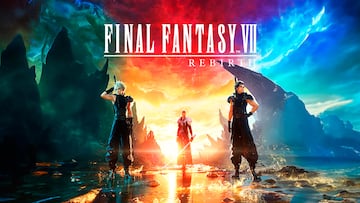
It’s been five years since Final Fantasy VII Remake blew the fans’ minds with an immaculate reimagination of the classic Square Enix RPG. We all doubted if it was really necessary to expand such a small part of the story into a full-blown game, only to marvel at how focused and incredible it all was. So ever since, with the promise of a bigger and more bombastic part of the story being adapted in Final Fantasy VII Rebirth, to say that our hype has been through the roof by looking at all the teases the developers have shared is a bit of an understatement.
Well, thanks to Square Enix, we have been able to play the full game ahead of its official release. And we have many thoughts about what fans are about to jump into. Has Tetsuya Nomura done it again, delivering a packed and complex second chapter that brings us more of what we love from FFVII? The answer is a definitive “yes, absolutely.”
But is it perfect? That question is perhaps one that is more important. While there is a whole lot of content to love and be amazed at, certain design decisions feel tacked on, hurting the overall experience for the sake of bragging rights. But we’ll get into more detail about it below.
The Reunion is at hand
Final Fantasy VII Rebirth is, at its core, a direct continuation of FFVII Remake. The second game of what is meant to be a trilogy of titles adapting the plot of the original FFVII from 1997, Rebirth picks up immediately after the events of Remake: Cloud, Aerith, Tifa, Barret, and Red XIII have managed to escape from Midgar and the Shinra Forces, and are now out in the world committed to stopping Sephiroth and whatever plan he has.
Aaaand that’s about as much as we’re willing to speak about when it comes to the plot. From its very first moments, Rebirth manages to surround itself with so much mystery and unexpected changes from the original material that it would be an injustice for anyone planning on playing the game once it is released. It is unequivocally a fantastic journey that is full of twists and turns at almost every pivotal moment of the story. Once again, the entire game is divided into chapters, so just as in Remake, you’ll have a chance to re-experience certain things you may have missed on your way.

And this time, it’s very probable that you will miss some stuff, perhaps even on purpose.
But first, let the battles begin
Before we speak about our issues with the game, let’s leave something clear: when the game clicks, it clicks hard. Specifically, we’re talking about the main thing you’ll be doing during the adventure other than enjoying the story: Combat.
In Final Fantasy VII Rebirth, the devs took the combat mechanics of Remake and basically dialed them up to 11. All of the main characters start over at level 15, but certain tweaks to the way fights work help you feel as if you’re as powerful as you were at the end of the previous game. Maybe you’ve lost most of your epic materia magic, but new abilities have been added to every party member, giving you many more options in combat that don’t always rely on materia.
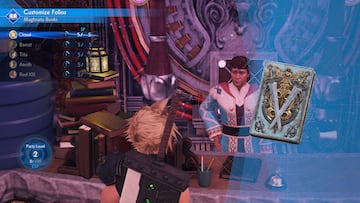
Through a new skill tree system called “Folios” that replaces the weapon level from Remake, you’ll be able to spend SP to unlock special moves as you fight on. Some can be passive upgrades that increase your stats, while others give you ability commands to use elemental attacks in combat that don’t cost any MP to use. But most importantly, you get to unlock Synergy Skills and Abilities, which are heavily expanded from what we saw in Remake Intergrade.
These are the greatest additions to the combat in Rebirth, allowing characters to join forces for special actions during combat and even unleash powerful and cinematic moves that obliterate enemies with ease. Synergy Skills can be used on command, calling on other characters to quickly help: Barret can get back to back with other members of the party to raise up their defense for a few seconds, while Aerith can call upon others to take damage in her place. Cloud can launch Tifa into the air to string some aerial combos, or reflect magic roars from Red XIII to strike fiends at range.
Meanwhile, Synergy Abilities are the more complex of the two, but also some of the more powerful moves you can pull off aside from Limit Breaks and summons. They are tandem moves that require two characters to work together, which also cost a new resource you can get during battles called Synergy. This is built up per character as they use certain types of commands during battle, from using items to casting magic or doing their unique attacks.
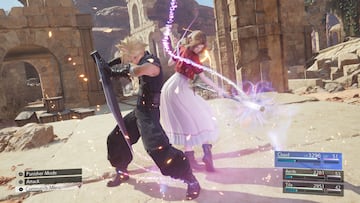
Once both characters have enough Synergy, you can use special commands in the Tactical Mode to unleash special attacks. Depending on your active party members and what you have unlocked in their Folios, you could get massive heals for the party, single target devastators, or screen-clearing attacks, all in the form of cinematic cutscenes right in the middle of a battle. It’s all incredibly fun and exciting, which only adds to an already great system.
The only negative there is with all of this is that, unless you played the first game, all of this might go over your head. The game lacks the same kind of explanation and tutorializing of its mechanics the previous title had, opting instead for pop-up tutorials that can be quickly closed and archived for later review, which is great news for veterans, but newer players might be left scrambling trying to wrap their heads around all of the minutiae of combat.
Bigger is not always better
Rebirth has opted to become a much more open experience. Not quite an “open-world”, the world of Gaia is presented as large, open, explorable environments that connect the various landmarks and towns you’ll be visiting during the story. The lands you will travel through are undoubtedly beautiful to look at, rendered in great details with, as you’ve certainly seen from trailers released so far, vast green pastures filled with flowers, swamps, wastelands, deserts, and some of the most dense cities and towns ever presented in any Final Fantasy game.
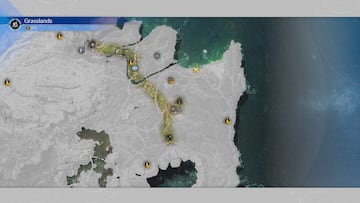
The problem is, aside from being pretty to look at, these open sections tend to only be filled with side content that distracts the player from the best part of the game: its epic plot. And while certain side missions are interesting, Final Fantasy VII Rebirth has inexplicably fallen into what we like to call “Far Cry Syndrome”: a big, empty map that you fill up with the same activities by activating towers (yes, seriously), with icons to chase after with little reward.
From the moment you activate your first tower, the game begins to bloat excessively through objective trackers to fill, lists to fill, icons to mark with a checkmark, and way too many meaningless directions to choose from. These objective markers typically take you to one of a small array of minigames to complete, or special variations of monsters from the area you’re in. After completing the activity you get an experience reward, and after completing a certain amount, other special activities may appear on the map.
While it may sound innocent enough, as its rewards aren’t all that interesting sounding at first, the truth is that many important features of the game are hidden behind these repetitive and often dull activities. From new summons to very special boss encounters that may or may not require you to complete everything there is in the game to unlock. For people who fancy themselves completionists, it may be heaven.
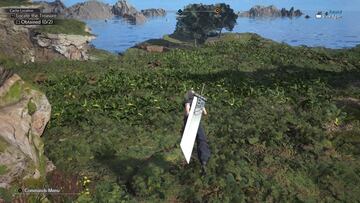
But for fans of the original, and even Remake, it might be exhausting and tedious. In those games the secrets were cleverly hidden around the world, tempting players with quick glimpses of special materia or treasure chests to pick up in inaccessible places, forcing them to explore the environment. In these open areas, those secrets demand you do samey chores strewn about an empty world, with only inconsequential and easy random fights in the way for you to entertain yourself.
Thankfully, the game hasn’t forgotten about what made the previous title so fantastic and connects its open regions with more linear experiences. These are where Rebirth truly shines, as everything from the pacing of the plot to character conversations (and especially battles) becomes highly focused, delivering what we actually wanted from the game in the form of an incredibly cinematic and beautiful experience.
But it is glaringly obvious that catering to the concept of an open map has hurt the game in general. Animations have become floaty, often sliding characters into place from fairly long distances when interacting with certain objects. Environmental textures like walls and trees often get in the camera’s way during conversations, as do random NPCs and even your party members. A patch has already been issued which fixes many graphical problems, but even so, there is texture popping and slow load times for visual elements both in the open world and linear segments of the title.
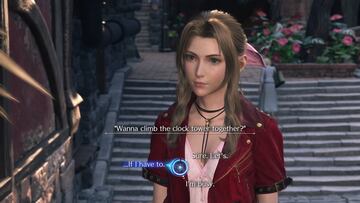
It is a sacrifice that Square Enix chose to make for the sake of having a bigger game, but one that ultimately hurts the experience quite a bit. This bloat extends even to the game’s many systems: there are separate levels for your characters, your weapons, and now even your party. Your relationship with the party members is now measured, constantly reminded of how your decisions and what you do in combat affect your bond with specific characters. By the end of the second chapter, you’ll have at least 4 different currencies, each with their own store to be spent at. You have skill trees that unlock new abilities, but each weapon also has its own unlockable skills with a separate level and experience, and Materia still needs to be leveled up individually through use…
The list goes on and on, resulting in a complexity that is almost bursting at the seams. There are two separate menus in the game, with at least a dozen submenus in total each dealing with one of the many different mechanics in the game. It wouldn’t be as bad if all of it was presented slowly throughout the game, but it happens almost incessantly during the first hours of the game. By the end of chapter 2, you’ll be juggling way too many things, with the adventure still to begin in full.
But even so, Gaia persists
All of these could have been absolute moodkillers, and are admittedly a very worrying picture of what the AAA industry does wrong repeating the same mistakes over and over again for the sake of chasing trends and bragging rights. But it’s still not enough to ruin the entire experience.
As we mentioned before, when Final Fantasy VII Rebirth is at its best, it shines brighter than many other titles currently on the market. Its production values are unimaginably high, with fantastic graphics and highly detailed models that beautifully render classic characters in a whole new light. Its combat is absolutely thrilling when it takes place in a well-paced dungeon, and the 4-act format to boss encounters is back to keep you on your toes with some of the most involved fights RPGs have ever had.
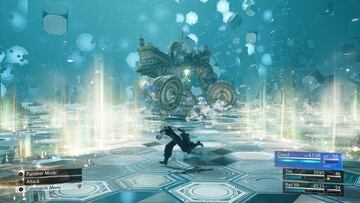
Of special note, we’d like to mention the soundtrack, as it knocks it out of the park monumentally at almost every point in the game. Apart from a few questionable tracks that feel extremely out of place in this game, the many battle themes of the game are adrenaline-pumping music that continually transforms as battles go on. World themes can get a bit grating after exploring a region for hours on end, but are still amazing renditions of the music composed by Nobuo Uematsu for the original title. Mitsuto Suzuki and Masashi Hamauzu did a fantastic job reworking the original songs, mixing together character themes with battle music and location-specific tunes to create a new and exciting soundtrack.
In the end, you don’t really need us to tell you whether you’re going to get Final Fantasy VII Rebirth or not. If you’ve been waiting for it all this time, the answer is clear: this is a fantastic experience that continues what Remake started, even if a bit flawed. In the pursuit of a bigger experience, some of the focus that made the first great is lost, but we hope it works as a lesson for whatever we may see in the last part of this trilogy.
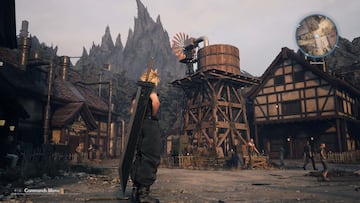
Oh, but please, fix the Moogles. These have got to be the ugliest, most nightmare-inducing version of the iconic creatures we’ve seen in all of the franchise’s history.